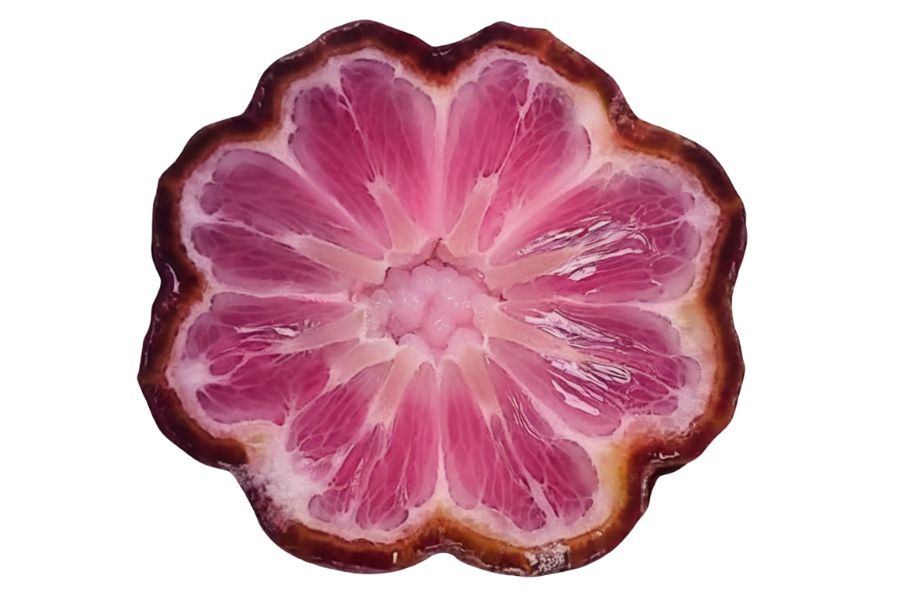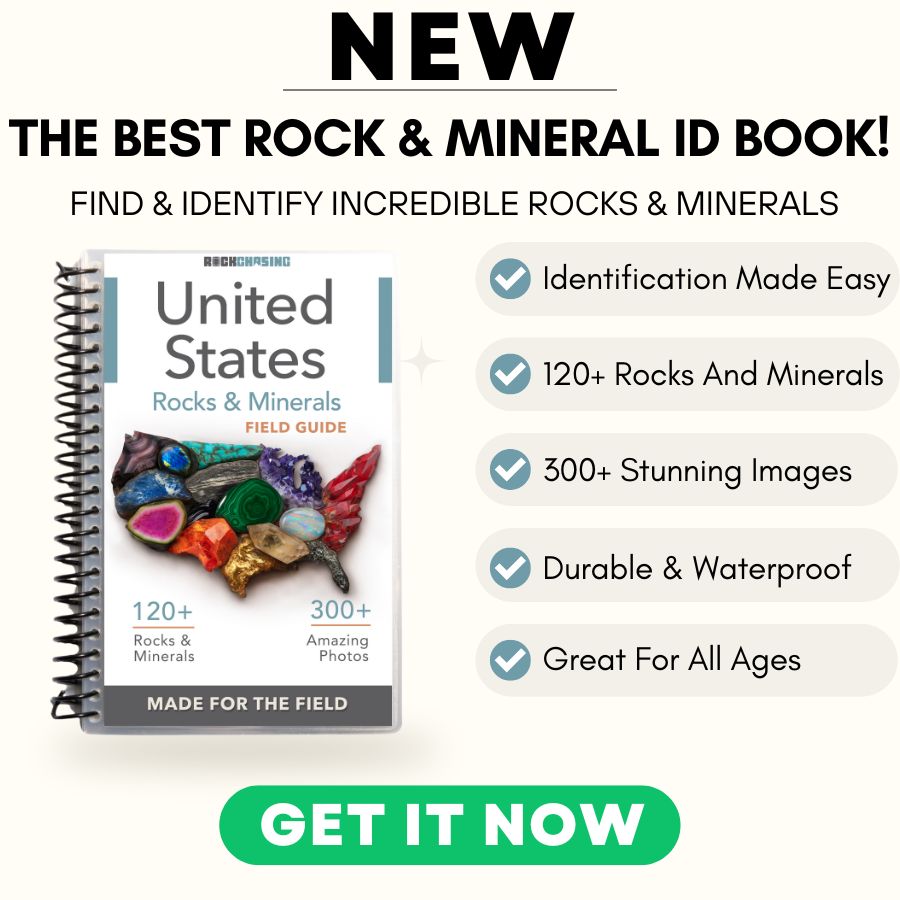Looking for rhodochrosite in Arizona feels like a mini adventure. The pink mineral hides in certain spots across the state, waiting for rock lovers to discover it.
I stumbled upon my first piece years ago. It was small but had that rose-pink color that makes rhodochrosite so special. Since then, I’ve been mapping out the best areas where others might get lucky too.
This guide shares real spots where rhodochrosite pops up more often. No fancy equipment needed to start, just some time and willingness to dig around. These locations work for both beginners and those who’ve been collecting for years.
How Rhodochrosite Forms Here
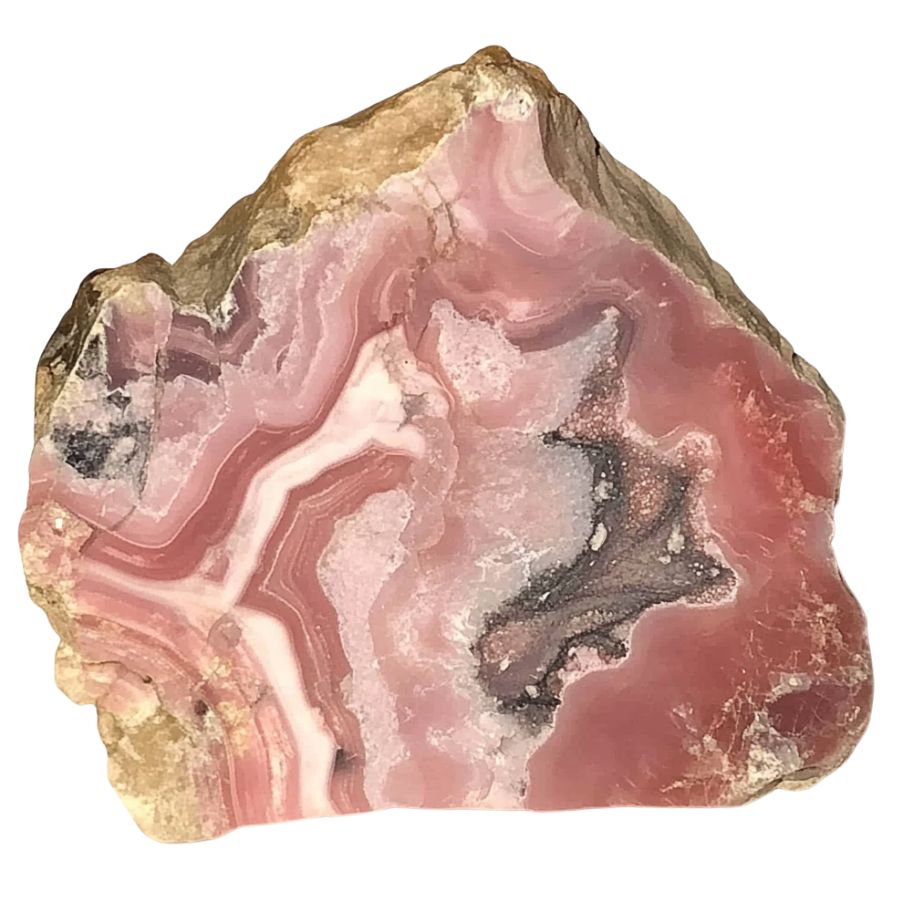
Rhodochrosite forms from manganese-rich waters seeping through cracks in rocks. When these mineral-heavy solutions mix with carbonate materials (like limestone), the magic happens!
Over time, as temperatures and pressures change deep underground, the manganese and carbonate ions come together and slowly crystallize. Sometimes, it forms in beautiful stalactites in empty spaces in rocks, while other times it shows up in hydrothermal veins alongside other minerals.
The most stunning specimens often form when the conditions are just right (not too hot, not too cold) letting the crystals grow slowly into those gorgeous pink rhombohedral shapes we love so much.
Types of Rhodochrosite
Rhodochrosite occurs in several distinct varieties. From delicate pink bands to deep crimson crystals, these variations showcase the diverse beauty of this remarkable mineral.
Pink Rhodochrosite
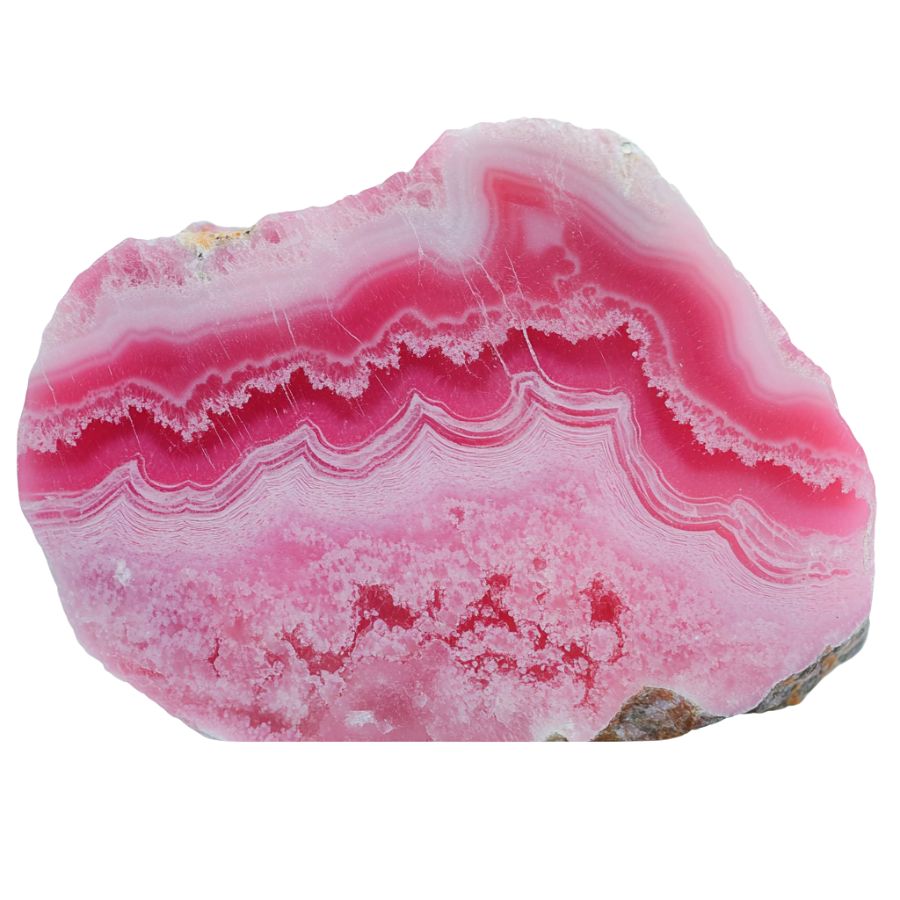
Pink Rhodochrosite displays delicate pink shades that range from soft pastel to deep rose pink. The stone features beautiful banding patterns that create swirling designs throughout its surface.
The translucent to semi-translucent nature of Pink Rhodochrosite adds to its visual appeal. This stone has a special trigonal crystal system that sometimes produces rare transparent crystals.
Fine specimens with clear, transparent crystals are particularly valuable. The best examples show sharp color zones and distinct banding patterns. Stone’s intricate patterns often resemble landscapes or abstract art.
Red Rhodochrosite
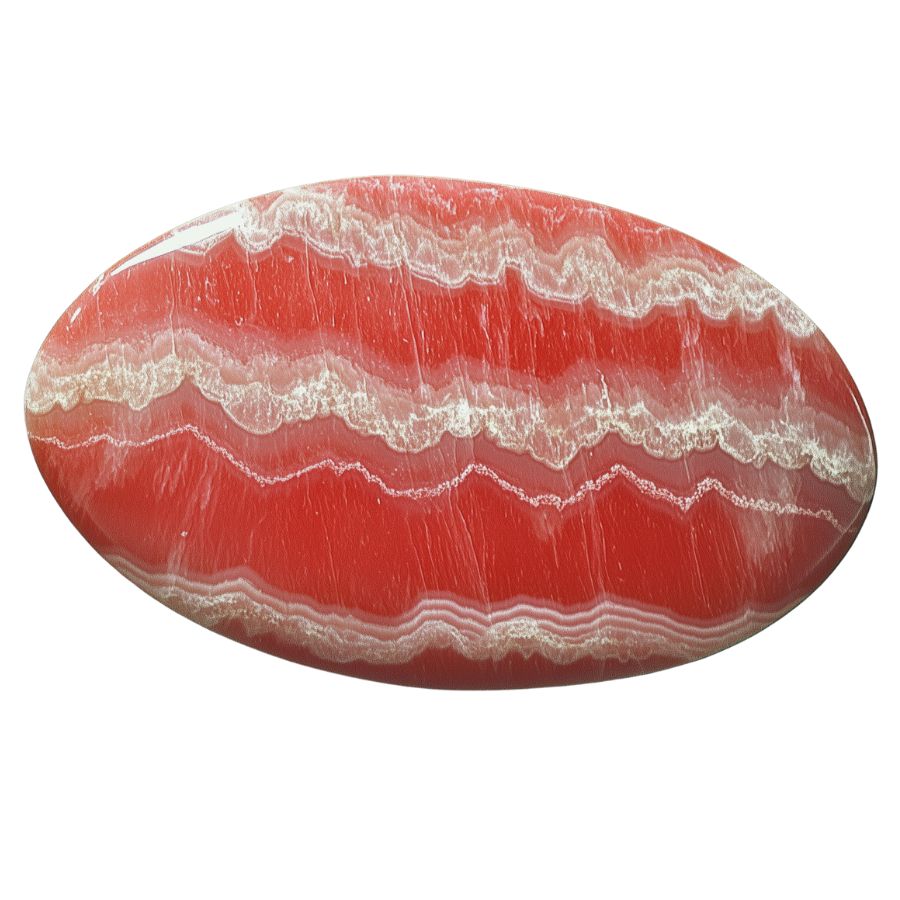
Red Rhodochrosite stands out with its bold, vibrant colors that range from bright red to deep crimson. Its intense red coloring comes from its high manganese content.
This variety can form in interesting shapes, including rhombohedral crystals and stalactite formations. When cut and polished, these formations reveal stunning internal patterns.
The crystal structure of Red Rhodochrosite allows it to form in large, well-defined specimens. These pieces often show sharp color transitions and clear crystal faces. The surface has a bright, glass-like shine when polished.
Some specimens feature dramatic color zoning, where deeper reds blend into lighter shades. This natural gradient effect makes each piece distinct and visually interesting.
Trapiche-like Rhodochrosite
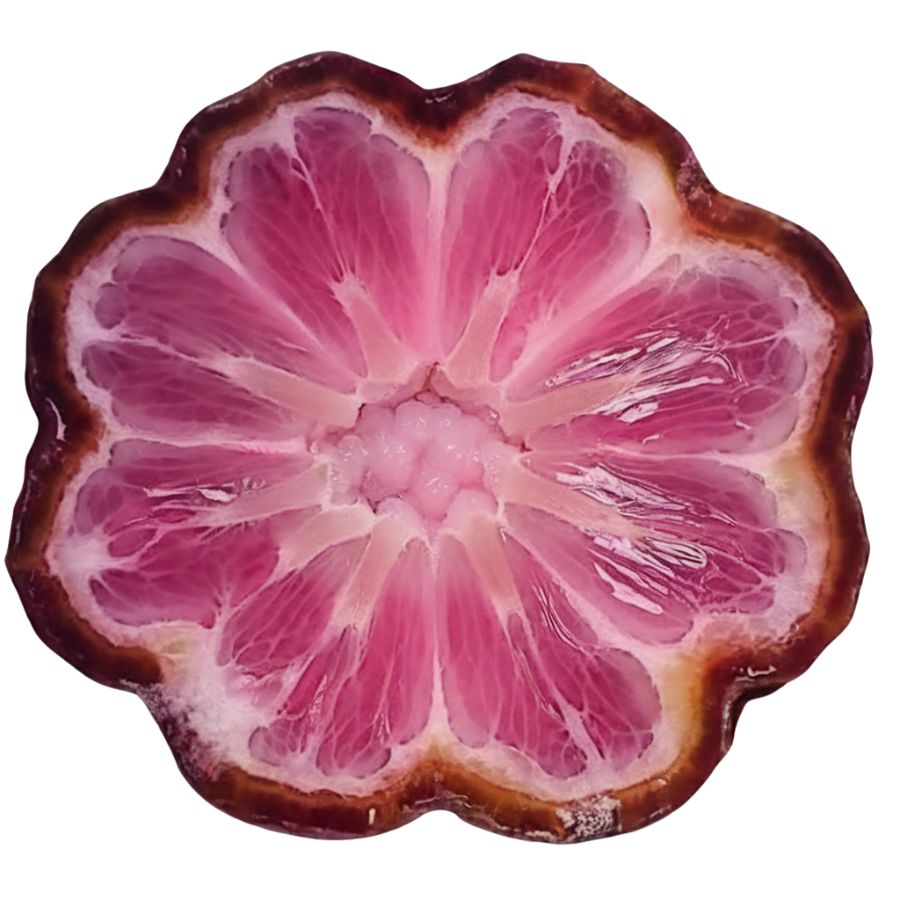
Trapiche-like Rhodochrosite showcases a remarkable star or flower-like pattern that makes it truly special. This pattern forms when crystals grow in a specific way, creating symmetrical rays that extend from the center. The result looks like a wheel with spokes or a blooming flower.
The formation process creates distinct sections within the crystal, each with its own character. These sections join at the center point, creating a natural geometric design.
When the stone is cut perpendicular to its main growth axis, its visual effect is enhanced. This orientation reveals the full beauty of the pattern and shows how the crystal sections fit together perfectly.
South African Rhodochrosite
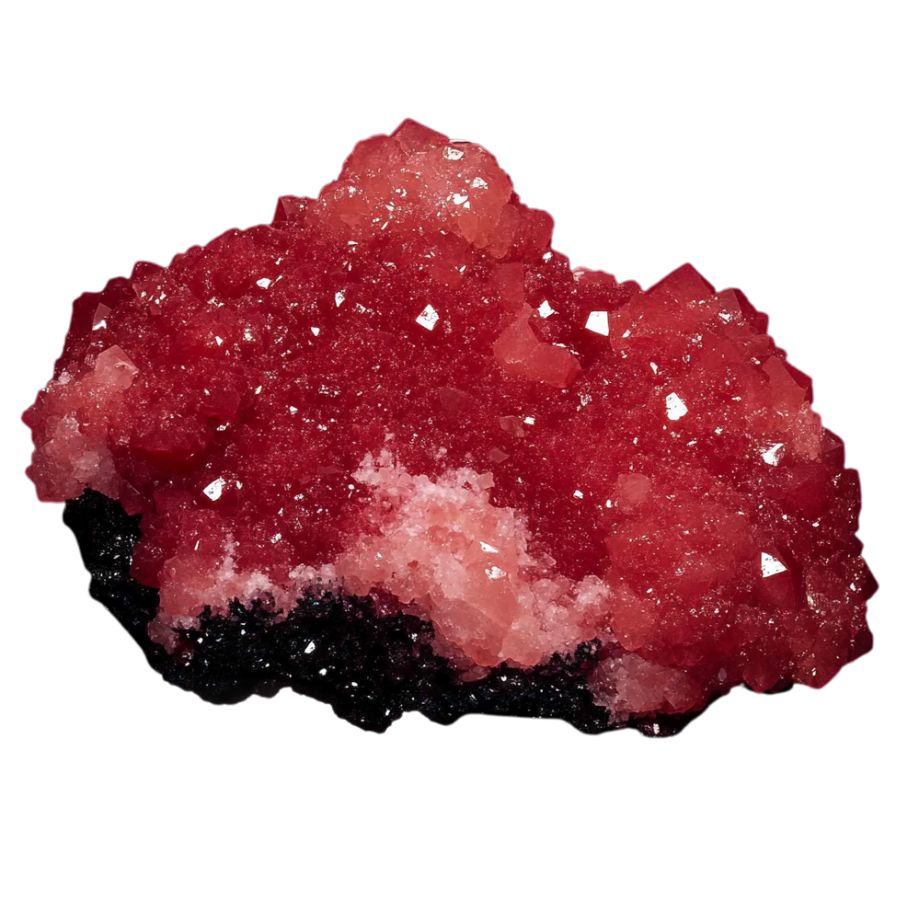
South African Rhodochrosite is known for its deep, rich blood-red color. This intense coloring sets it apart from other varieties. The stone often shows excellent clarity and depth of color which makes it particularly striking.
The internal structure of this variety creates interesting optical effects. When light passes through the stone, it can create a subtle glow that enhances its natural beauty. The crystal structure allows for excellent polish, bringing out the stone’s natural luster.
Many specimens show distinctive growth patterns that form during crystallization. These patterns can create interesting visual effects, from subtle color variations to dramatic geometric designs. The combination of deep color and natural patterning makes each piece unique.
Argentine Rhodochrosite
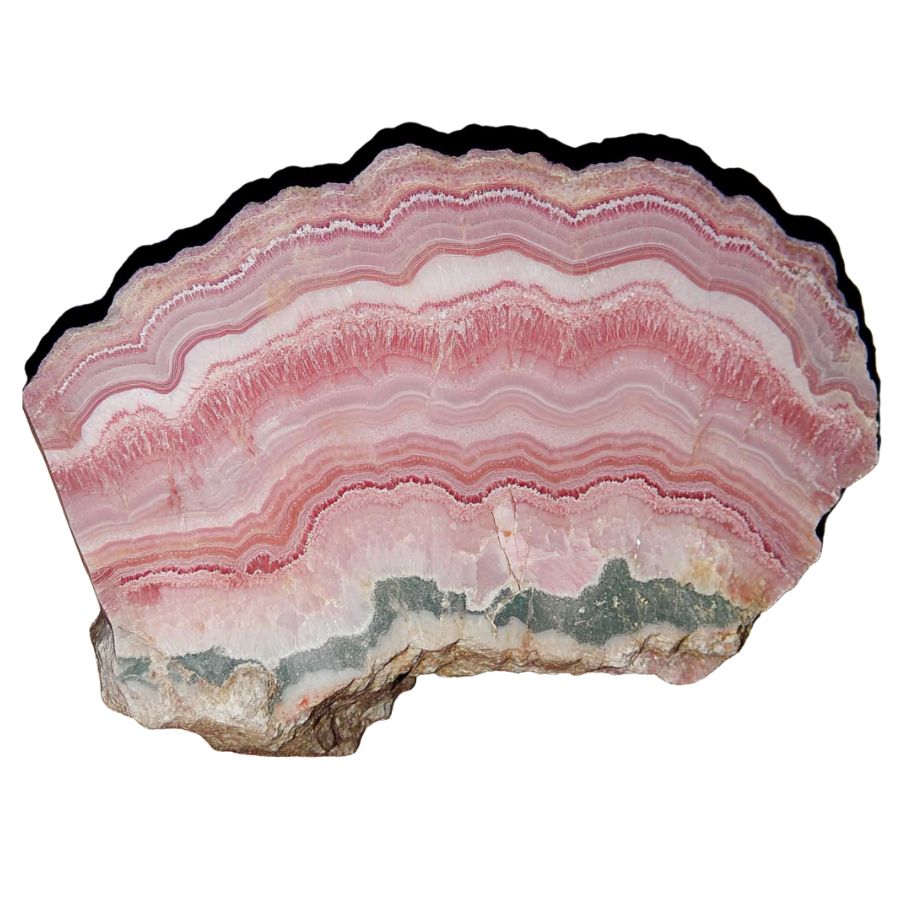
Natural bands of pink and white create stunning patterns across this remarkable stone. Delicate layering resembles fine marble artwork, making each piece unique. The colors shift between pale pink and deep red tones.
Historic significance adds to its charm as the “Inca Rose.” Ancient civilizations treasured these stones for their exceptional beauty. Many specimens show perfect crystal formations that catch and reflect light beautifully.
Exceptional purity sets Argentine specimens apart from others. Crystal formations often grow in perfect rhombohedral shapes. Traditional cutting methods reveal intricate internal patterns that collectors prize.
Colorado Red Rhodochrosite
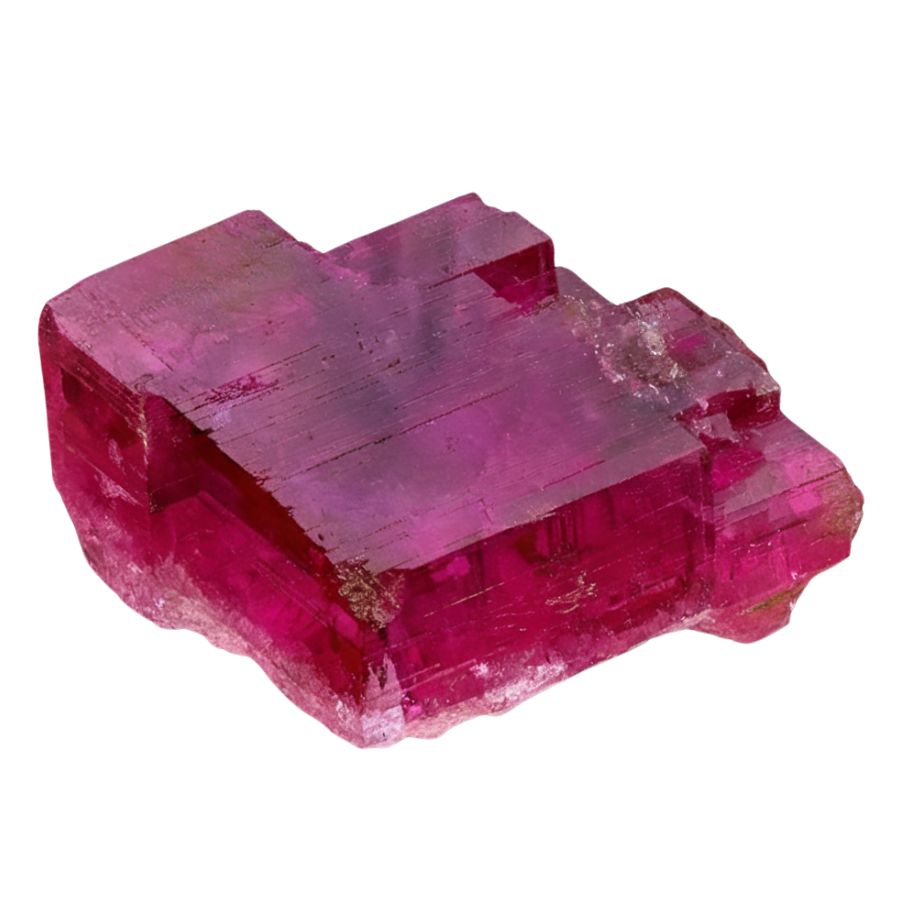
Brilliant rose-red colors distinguish this remarkable variety. Transparent specimens showcase exceptional clarity and fire. Natural light brings out deep crimson undertones that seem to glow from within.
Outstanding crystallization creates sharp, well-defined faces. Remarkable internal structures form during slow growth periods.
Superior brilliance makes these stones stand out in collections. Natural light reveals complex internal reflections. Fresh specimens maintain their vivid coloring over time. Special cutting techniques enhance the stone’s natural beauty.
Banded Rhodochrosite
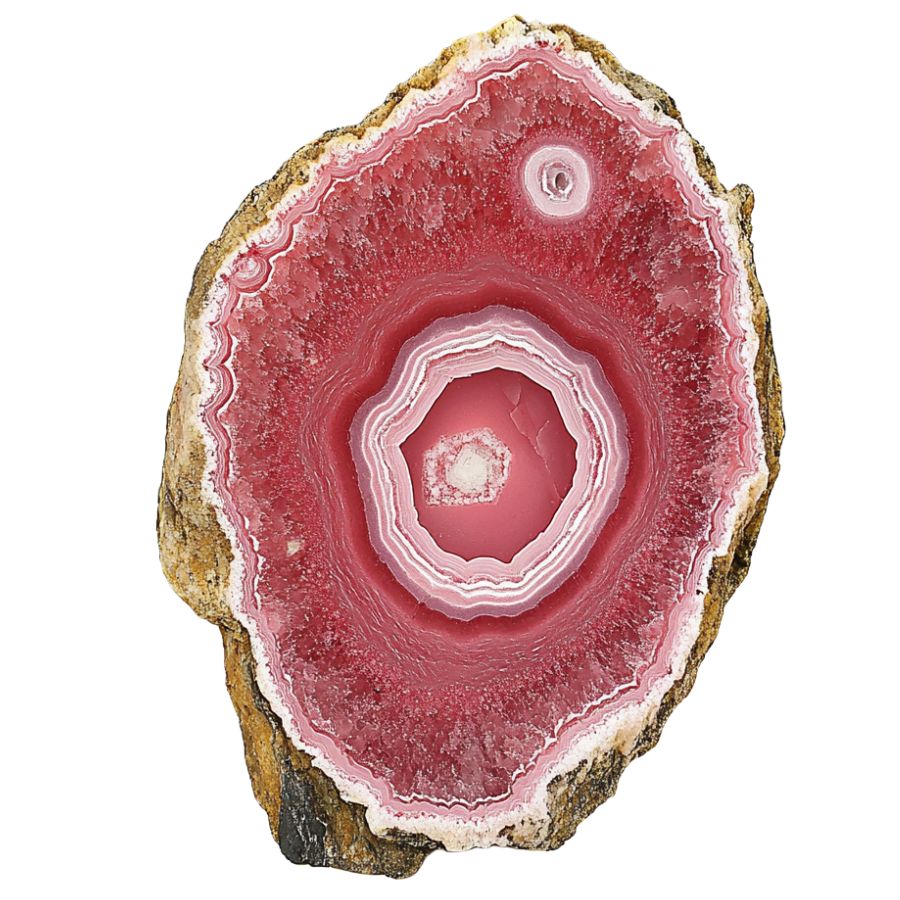
Concentric circles create fascinating patterns throughout this stone. Dramatic bands alternate between light and dark pink shades. Nature’s artistry reveals itself in each cross-section.
Perfect specimens form when mineral-rich water drips slowly over time. Natural processes create stalactite formations with distinct ring patterns.
Multiple layers build up over time to create unique patterns. Natural variation ensures no two pieces look exactly alike. Perfect cross-sections show complete circular patterns.
Peruvian Rhodochrosite

Peruvian Rhodochrosite exhibits a unique blend of pink tones with distinctive crystalline qualities. These stones often develop with exceptional clarity and a glass-like shine.
Crystal formation in these specimens tends to create angular patterns rather than rounded bands. This geometric growth pattern results in fascinating internal architectures that catch and reflect light in unique ways.
The combination of clarity and internal patterns makes these stones particularly fascinating under magnification. Collectors can observe minute details of crystal growth and formation that provide insights into the stone’s development process.
What Rough Rhodochrosite Look Like?
Rhodochrosite in its rough form can be tricky to spot, but once you know what to look for, it’s quite distinctive. Here’s how to recognize Rhodochrosite in its natural state.
Look for the Signature Pink-to-Red Color Range
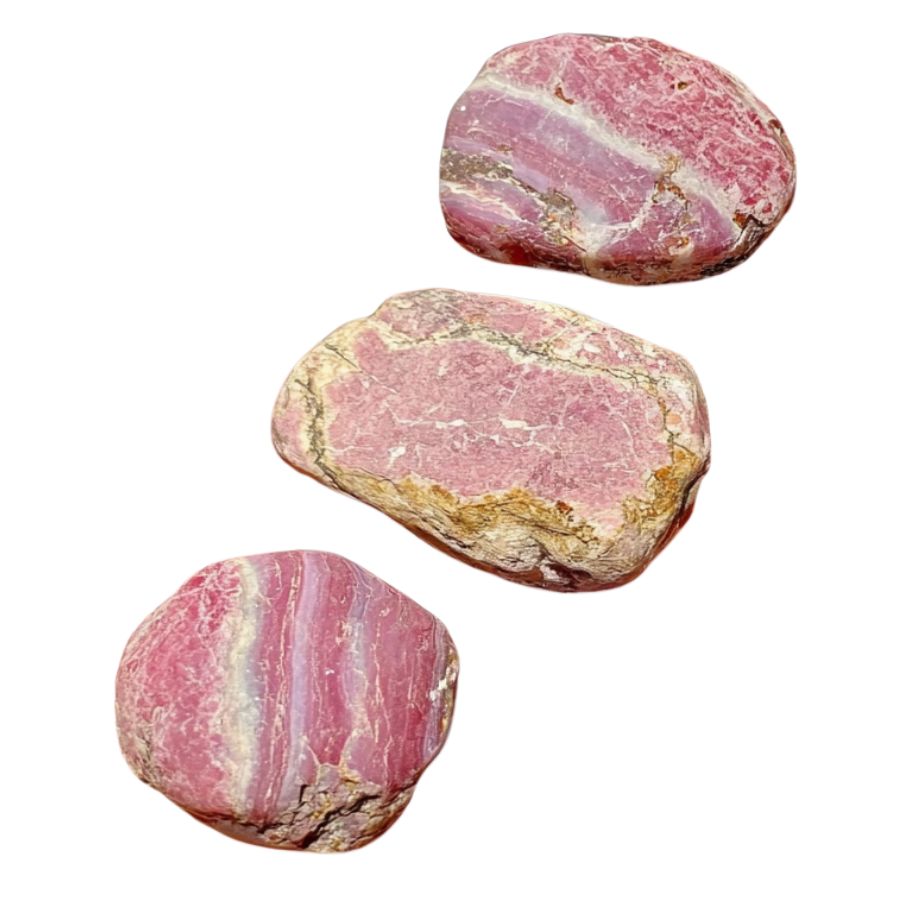
The most obvious telltale sign is its color – typically a warm, rosy pink to deep red. But here’s the thing: it’s not just one solid color. You’ll often spot subtle bands or zones of different pink shades.
Sometimes, you might see hints of brown or even light orange. Don’t dismiss it if it’s not perfectly pink – natural rhodochrosite can be surprisingly varied. The deeper, more saturated reds usually indicate higher-quality specimens.
Check for the Distinctive Crystal Structure

Unlike many minerals, rough rhodochrosite often forms in rhombohedral crystals. Look for angular edges and faces that meet at about 73 degrees. Sometimes you’ll find it in curved, saddle-shaped crystals (super unique!).
The crystals can be transparent to translucent, and they might appear in clusters or as individual specimens.
Examine the Surface Texture and Patterns
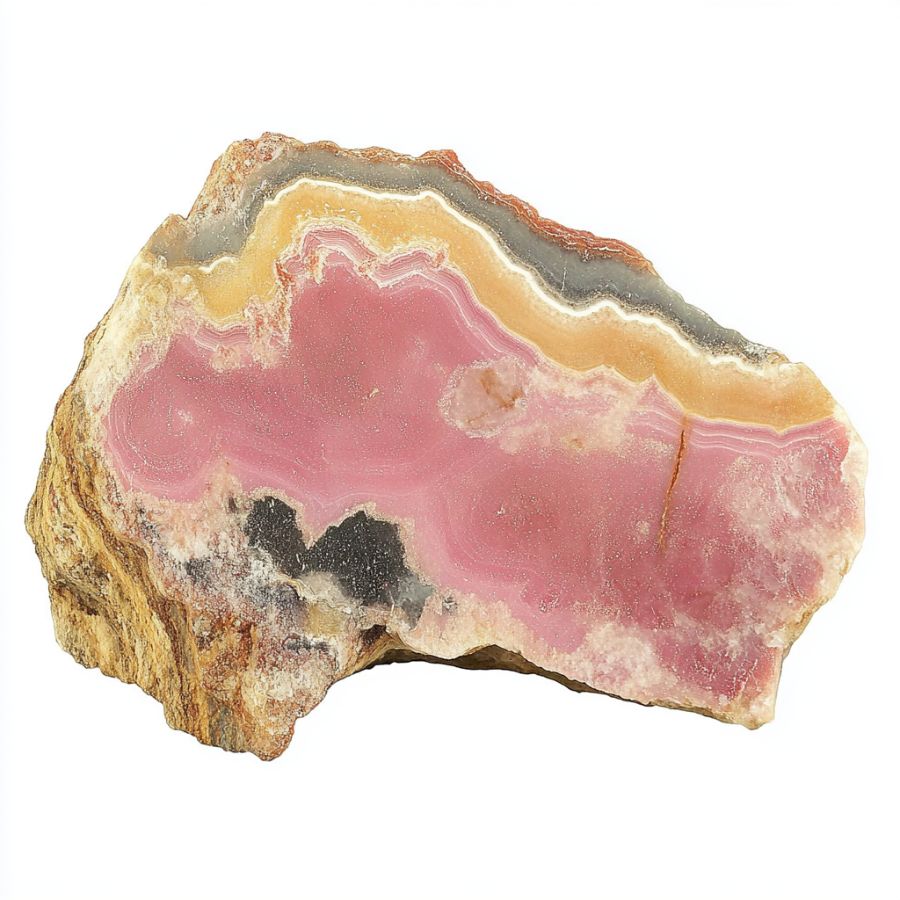
Run your fingers over the surface – rhodochrosite typically has a pearly to vitreous (glass-like) luster. Fresh breaks will show this best.
You might notice concentric banding patterns, especially in massive specimens. These bands often alternate between lighter and darker shades of pink. The surface might feel slightly smooth but not quite as glassy as quartz.
Test the Hardness and Fragility
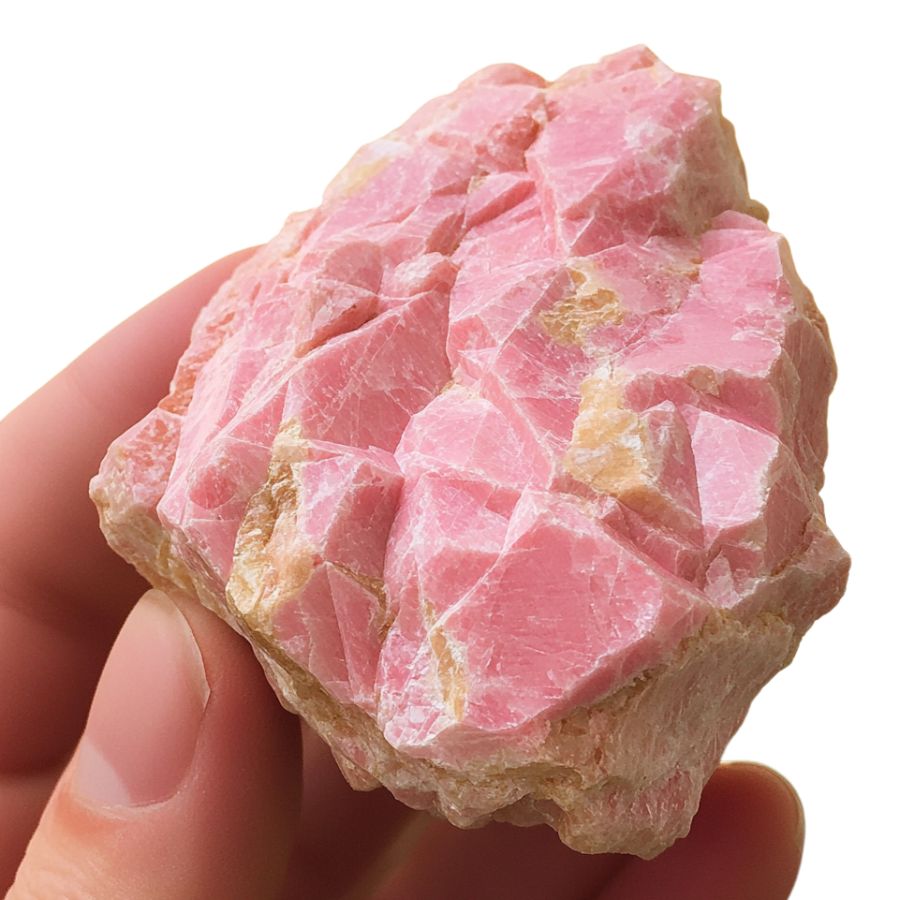
Here’s a crucial tip: rhodochrosite is relatively soft (3.5-4 on the Mohs scale). Try scratching it gently with a copper penny – if it scratches easily, you might have rhodochrosite.
Be gentle though! It’s pretty delicate and can break along cleavage planes. This softness and brittleness help distinguish it from similar-looking minerals like rose quartz, which is much harder.
A Quick Request About Collecting
Always Confirm Access and Collection Rules!
Before heading out to any of the locations on our list you need to confirm access requirements and collection rules for both public and private locations directly with the location. We haven’t personally verified every location and the access requirements and collection rules often change without notice.
Many of the locations we mention will not allow collecting but are still great places for those who love to find beautiful rocks and minerals in the wild without keeping them. We also can’t guarantee you will find anything in these locations since they are constantly changing.
Always get updated information directly from the source ahead of time to ensure responsible rockhounding. If you want even more current options it’s always a good idea to contact local rock and mineral clubs and groups
Tips on Where to Look
Rhodochrosite is a pink to rose-red mineral that often forms in veins and cavities. Here’s where you can typically find this beautiful stone while rockhounding in accessible locations across the US.
Abandoned Mine Areas

Old mines are great spots to find rhodochrosite. Check the mine dumps and tailings piles where miners discarded unwanted material. These areas often contain smaller pieces that weren’t commercially valuable but are perfect for collectors.
Look for pink-colored rocks in manganese-rich waste piles. The stone frequently appears alongside black manganese minerals, which can serve as a helpful indicator when searching.
Sometimes, you might get lucky and find specimens with beautiful banding patterns that were overlooked during mining operations.
Sedimentary Rock Formations
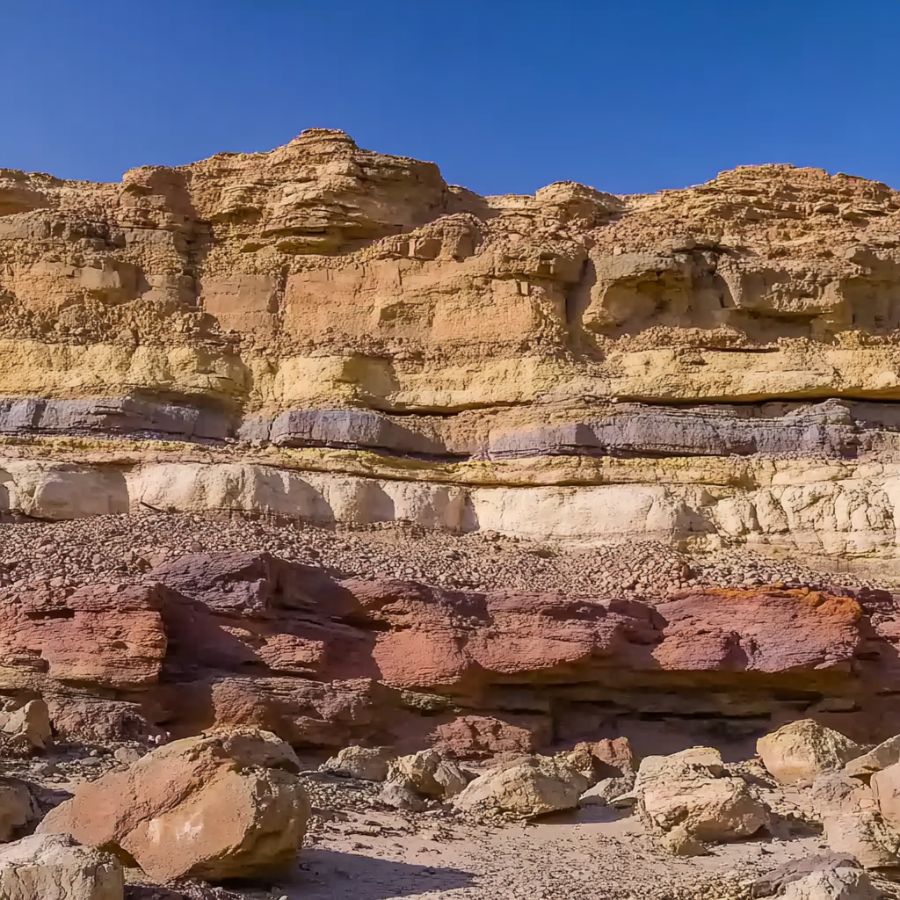
Many sedimentary rocks, especially those containing lots of manganese and calcium carbonate, can host rhodochrosite. Look for areas where limestone and dolomite are common. The stone often forms in the cracks and spaces between these rocks.
While exploring these formations, pay special attention to areas where water has carved out natural exposures, as these spots might reveal hidden rhodochrosite deposits that have been naturally weathered out over time.
Mountain Stream Beds

Stream beds in mountainous regions are excellent places to search. Focus on areas where the water has cut through manganese-rich rock formations, as the stream’s natural tumbling action often exposes and smooths rhodochrosite pieces.
During your search, concentrate on spots where the water slows down and creates natural collection points, such as behind large boulders or in quiet pools, because these areas tend to accumulate heavier minerals including rhodochrosite fragments that have broken free from their original source.
Some Great Places To Start
Here are some of the better places in the state to start looking for Rhodochrosite:
Always Confirm Access and Collection Rules!
Before heading out to any of the locations on our list you need to confirm access requirements and collection rules for both public and private locations directly with the location. We haven’t personally verified every location and the access requirements and collection rules often change without notice.
Many of the locations we mention will not allow collecting but are still great places for those who love to find beautiful rocks and minerals in the wild without keeping them. We also can’t guarantee you will find anything in these locations since they are constantly changing.
Always get updated information directly from the source ahead of time to ensure responsible rockhounding. If you want even more current options it’s always a good idea to contact local rock and mineral clubs and groups
Patagonia Mountains
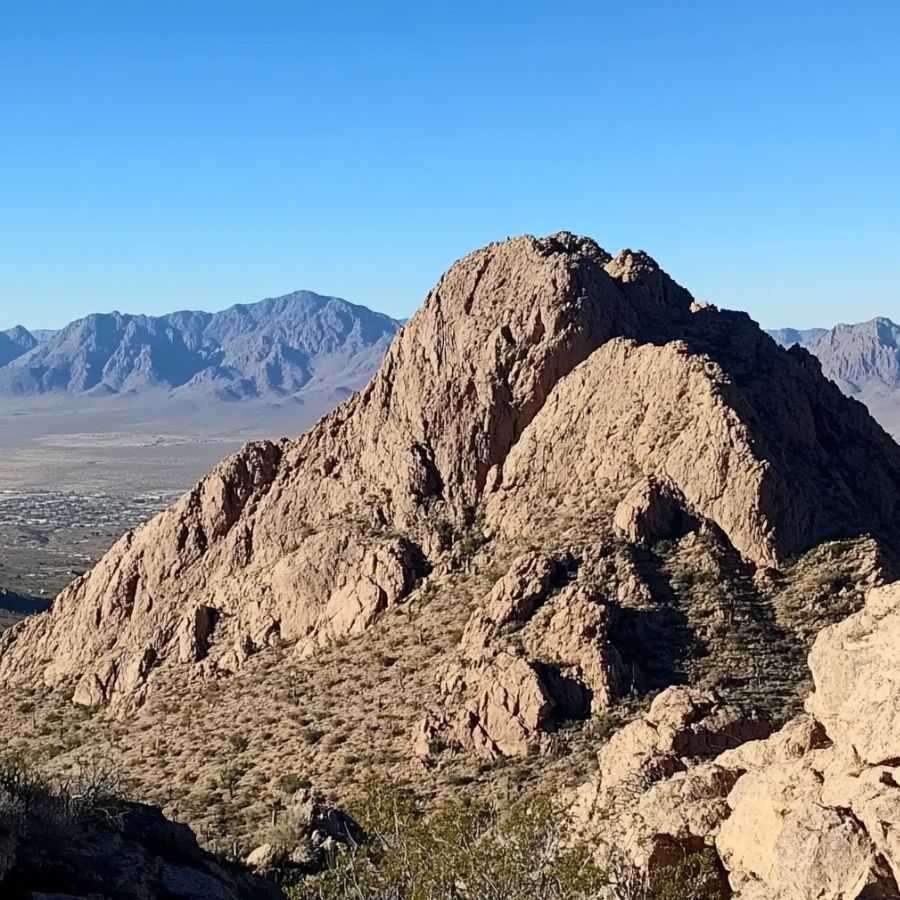
Located in Santa Cruz County, the Patagonia Mountains are a range that runs about 15 miles north from the U.S.-Mexico border and are part of Coronado National Forest. This area has a rich mining history, with old mining towns like Mowry, Washington Camp, and Harshaw scattered throughout the range.
Mineral deposits in the mountains were formed millions of years ago and are notably complex. These deposits include various metals like copper, silver, lead, zinc, and manganese.
At Red Hill in Providencia Canyon, the Four Metals Mine is a great spot to look for rhodochrosite. This site is part of the Patagonia Mining District and has documented rhodochrosite specimens. The mineral typically occurs in veins alongside other minerals.
Elevations in the rugged terrain reach up to 7,221 feet at Mount Washington. Hiking these slopes might reveal rhodochrosite in outcrops where manganese deposits are exposed by erosion or past mining activity.
Ash Peak
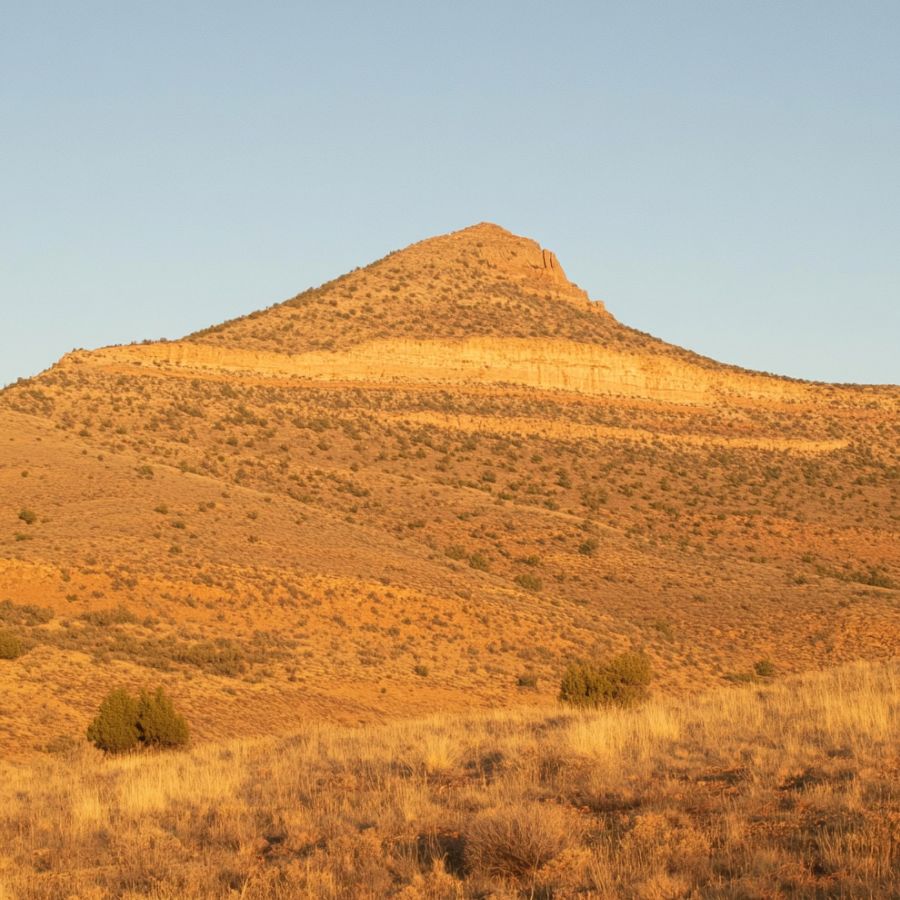
Ash Peak sits about 12 miles west of Duncan in Greenlee County. This area features rough terrain and is part of the Basin and Range Province, known for its mountain ranges separated by flat valleys.
The area has layers of volcanic rocks like andesite and rhyolite, with many dikes and volcanic plugs cutting through them. This complex geology created perfect conditions for mineral formation.
Rhodochrosite appears in the silver-bearing quartz veins that run through the volcanic rocks. These veins formed when hot, mineral-rich water flowed through cracks in the rock. The pink mineral often occurs alongside quartz, pyrite, and silver minerals.
Old mine tunnels and shafts throughout the Ash Peak Mines property provide access to these veins. After rain, new rhodochrosite specimens sometimes wash out onto the slopes below the main veins. The waste rock piles near old mine entrances also offer good hunting grounds for collectors seeking this beautiful pink mineral.
Twin Buttes

Twin Buttes is located in the Pima Mining District within the Sierrita Mountains. It sits about 25 miles south of Tucson. The area gets its name from two hill formations that stand out against the landscape.
The geology here spans billions of years. Old granite from Precambrian times lies beneath layers of sedimentary and volcanic rocks. About 70 million years ago, molten rock pushed up through these layers, bringing minerals with it.
Twin Buttes Mine is a prime location for finding rhodochrosite. The pink mineral forms where the molten rock touched limestone, creating special zones called skarns. These contact zones provided the perfect chemistry for rhodochrosite crystals to grow.
Another good spot is the Vulcan Mine near Mineral Hill. Similar to Twin Buttes Mine, rhodochrosite formed here when granite intruded into limestone.
The area also yields other interesting minerals. Copper minerals like chalcocite and chalcopyrite are common. Iron sulfides and oxide minerals can be found throughout the mineralized zones of this historically significant mining district.
Harshaw
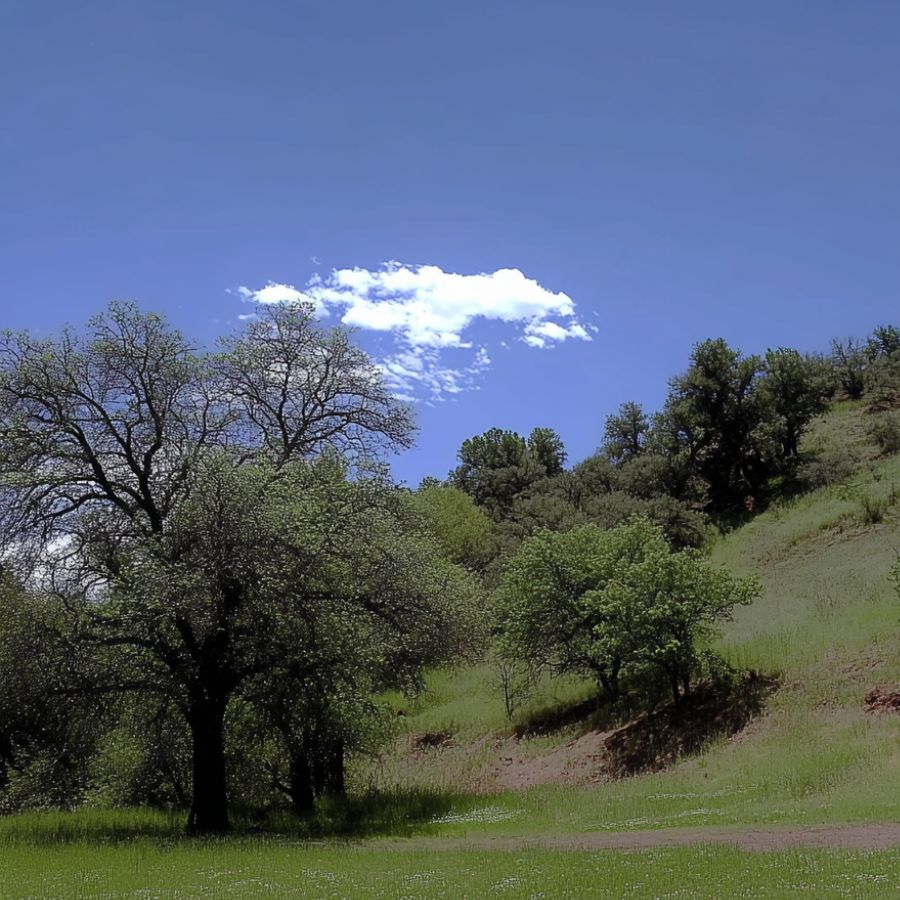
Harshaw is a ghost town in Santa Cruz County within the Patagonia Mountains of Arizona. Founded in the 1870s, it once thrived with about 2,000 residents during its mining heyday. The town was named after David Tecumseh Harshaw, who discovered silver in the area.
The rock layers around Harshaw include limestone, quartz diorite, granite porphyry, rhyolite, and andesite. These diverse rocks contributed to the area’s mineral wealth. Mining operations extracted silver, zinc, lead, copper, gold, and manganese until the mines closed in the 1960s.
Rhodochrosite can be found in specific mines within the Harshaw Mining District. The Humboldt Mine in Alum Gulch has documented specimens of this pink manganese mineral. Another promising location is the Alta Mine in Hardshell Gulch.
The limestone formations in the area are especially good for rhodochrosite hunting. These rocks often contain manganese-silver ore deposits where the distinctive rose-colored mineral forms. The abandoned mines and surrounding hillsides offer opportunities to spot the vibrant pink crystal among the weathered rocks.
Springerville

Springerville is a town in Apache County, sitting at about 7,000 feet elevation. The area is famous for the massive Springerville Volcanic Field that surrounds it.
This volcanic field covers about 1,158 square miles and contains more than 400 volcanoes. Volcanic activity began here around 3 million years ago, with the last eruptions happening about 300,000 years ago.
Black basalt rocks dominate the landscape, creating a unique terrain of cinder cones, lava flows, and flat-topped mesas.
Rhodochrosite occurs near Springerville in some unusual places, particularly in unnamed petrified wood localities. The pink mineral has been documented in association with petrified wood deposits in the area.
Places Rhodochrosite has been found by County
After discussing our top picks, we wanted to discuss the other places on our list. Below is a list of the additional locations along with a breakdown of each place by county.
| County | Location |
| Cochise | Bisbee |
| Cochise | Higgins Mine |
| Cochise | Hilltop Mine |
| Cochise | Humboldt Mine |
| Cochise | Commonwealth Mine |
| Cochise | Lucky Cuss Mine |
| Coconino | Grand Canyon Village |
| Coconino | Orphan Mine |
| Gila | Apex Mine |
| Gila | London-Arizona Mine |
| Gila | London Range shaft |
| Gila | Bucket Mountain area |
| Gila | Pinal Creek |
| Mohave | Wallapai Mining District |
| Pima | North slope of the Pima |
| Pinal | Magma Mine |
| Santa Cruz | Humboldt Mine |
| Santa Cruz | Blue Nose Mine |
| Santa Cruz | Alta Mine |
| Santa Cruz | Four Metals Mine |
| Yavapai | Midnight Owl Mine |
| Yuma | North Star Mine |

